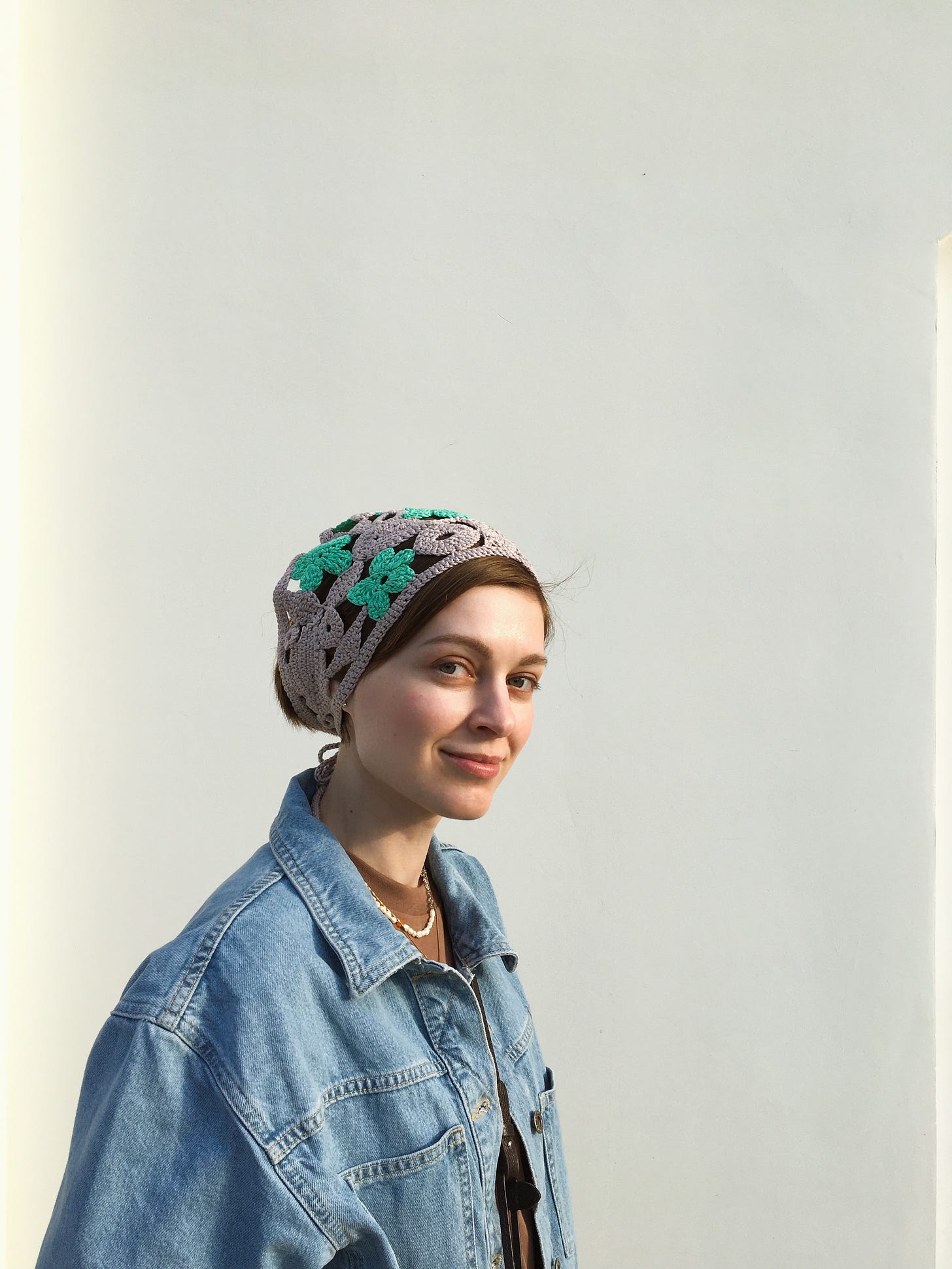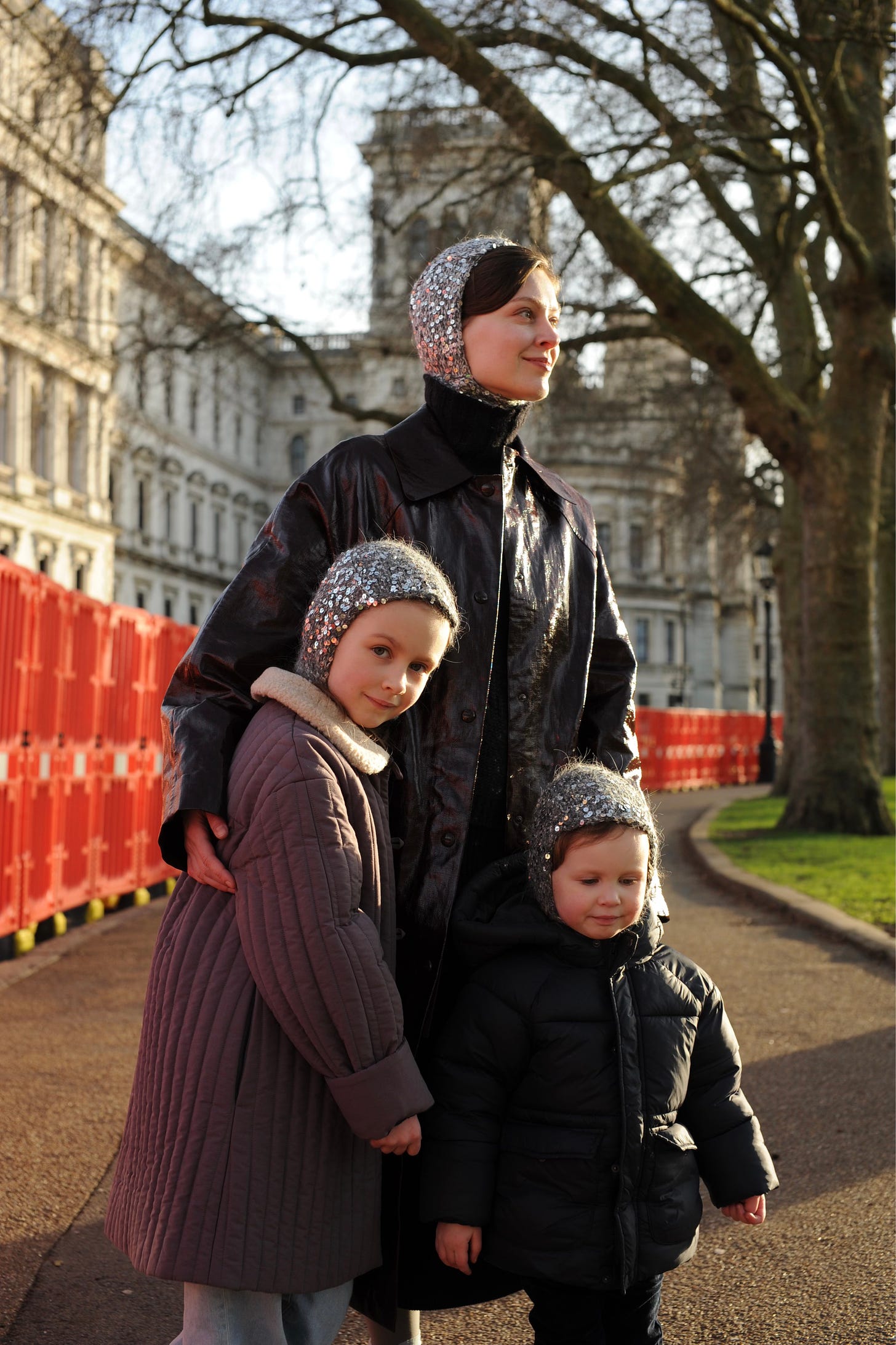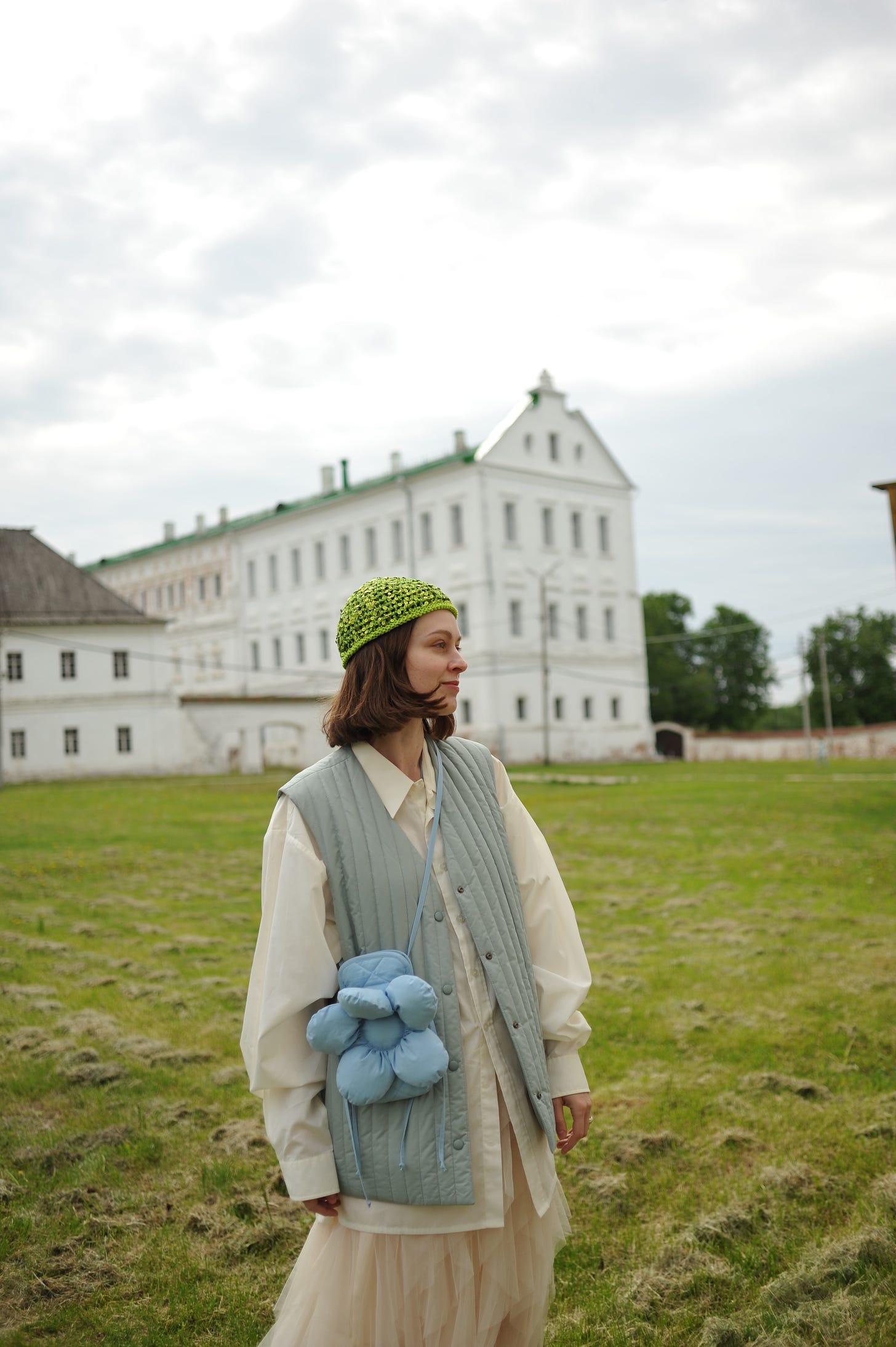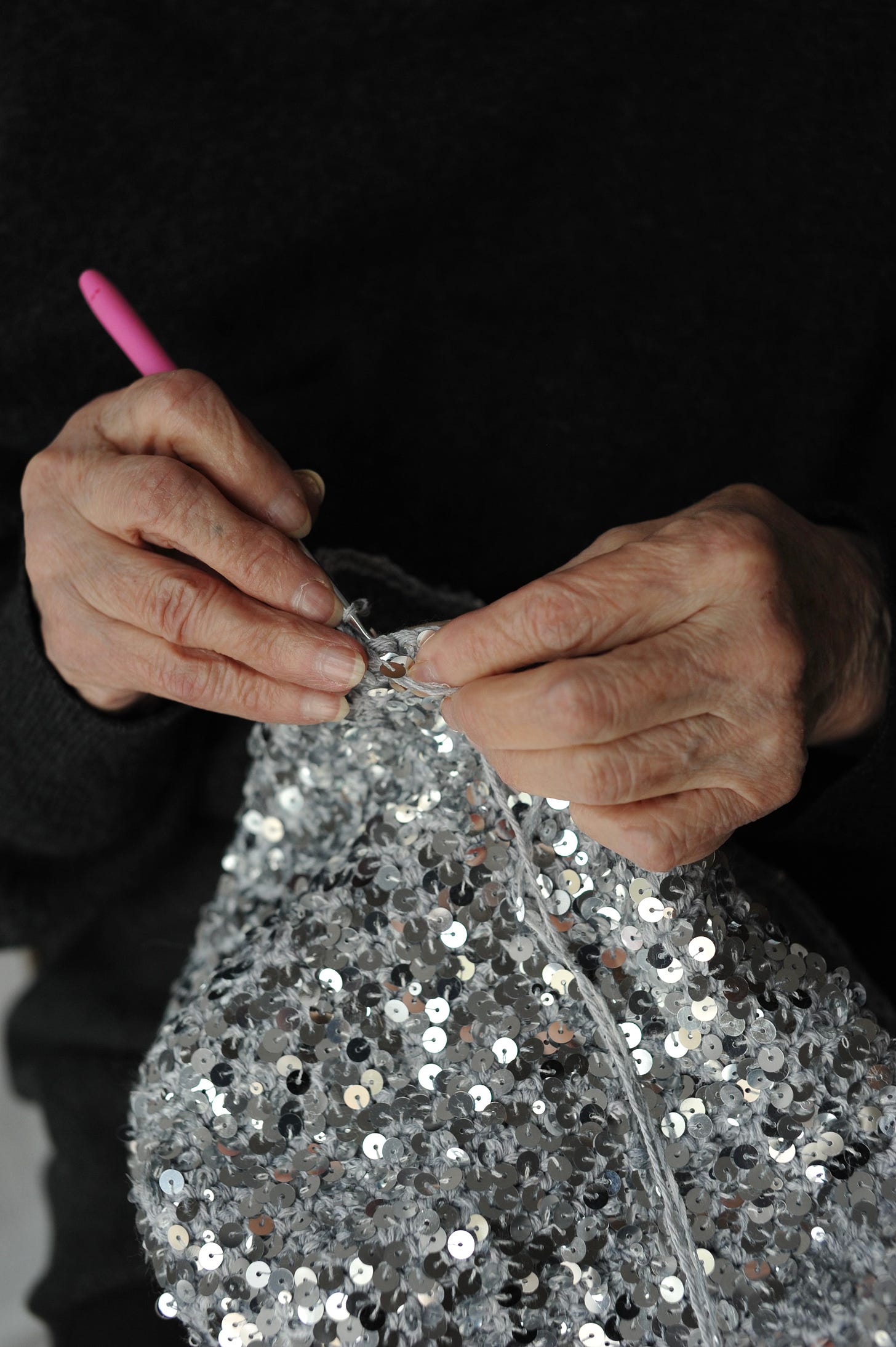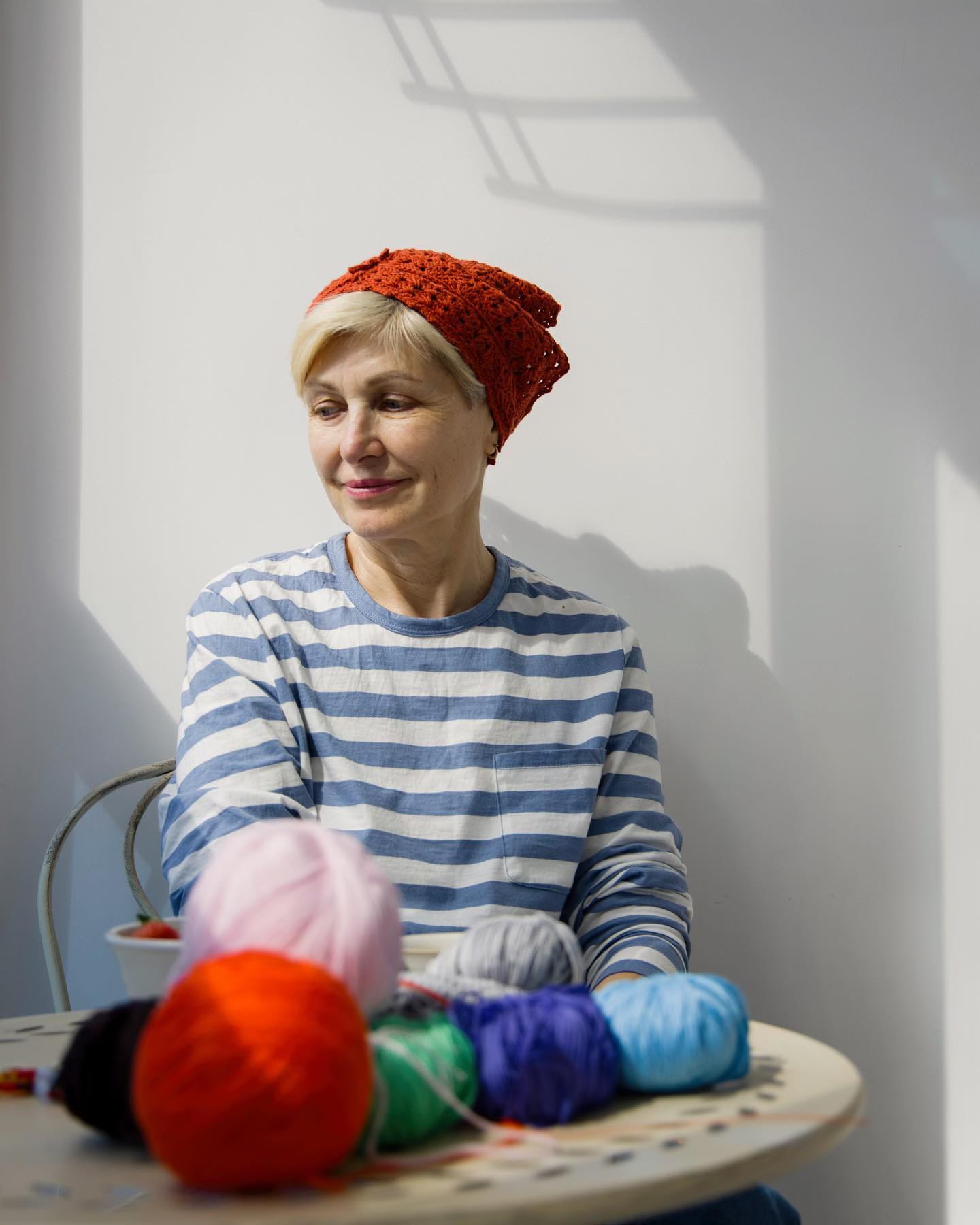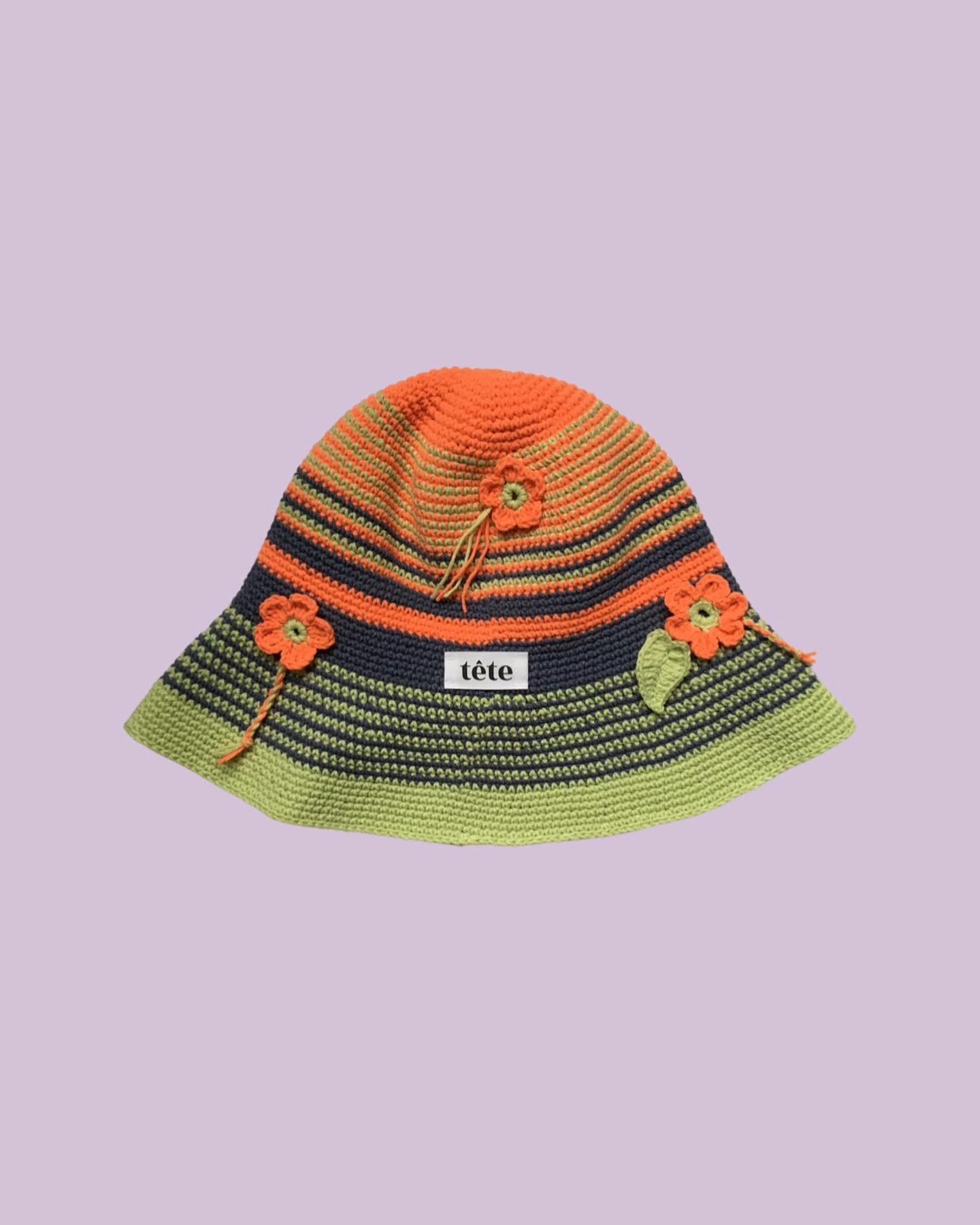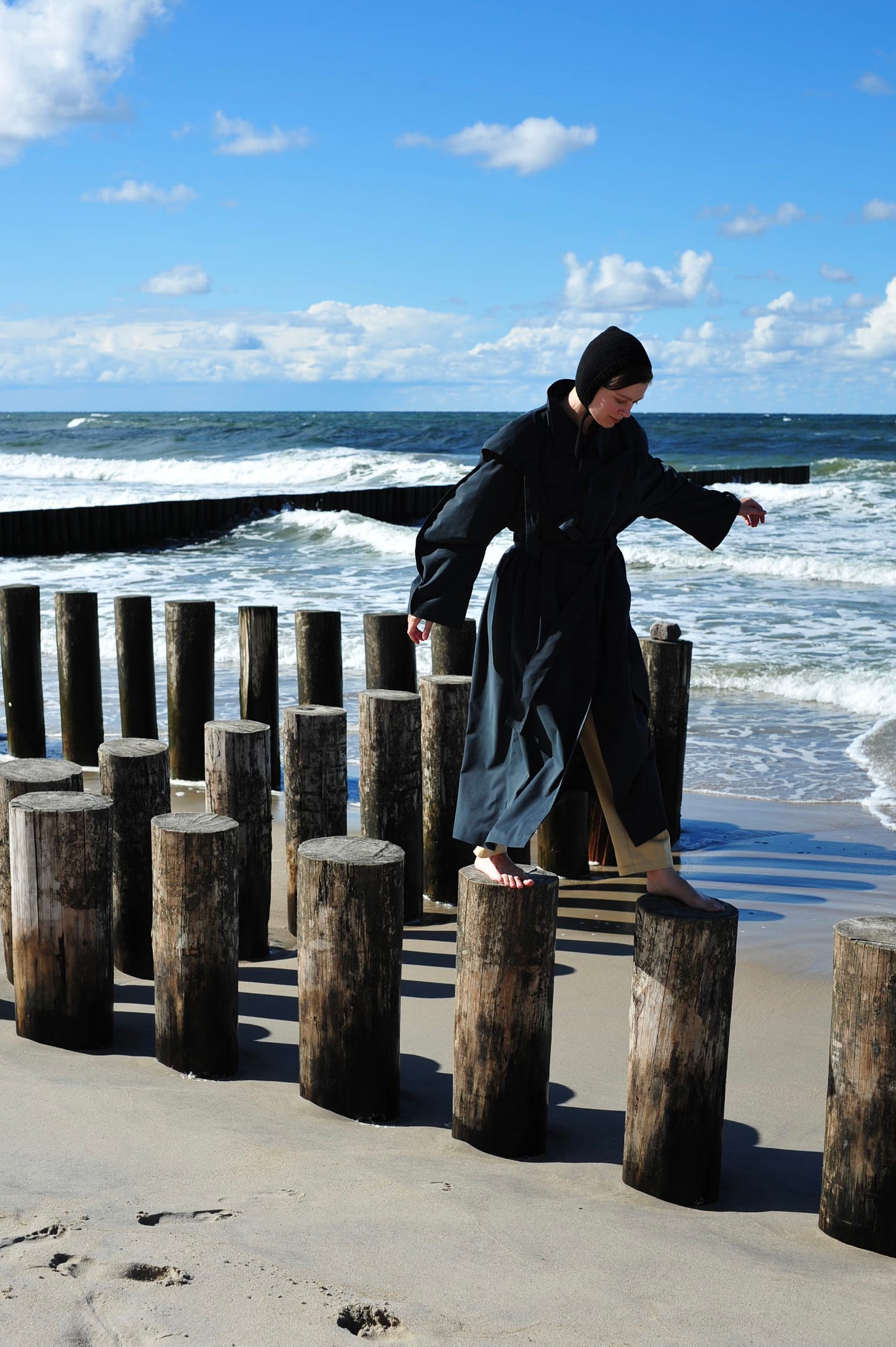Babushkas And Vogue
tête bonnet is a family brand of unique fashion accessories by Russian babushkas, and this is a heartfelt interview with the brand's founder whose mission was to give her relatives a living
The magic of fashion is that you start with something small and you see it grow into something that ends up on the catwalk, said the inimitable Dries van Noten.
It works the other way too. Sometimes you see something on the catwalk, an accessory let’s say, and your mind does not let go of it, but the original is too expensive and a dupe from Zara doesn’t wear well or long, and you start something new with your mother and grandmothers that very fast ends up on the pages of Vogue. The ‘something on the catwalk' in this story was a knitted balaclava in the Miu Miu Fall/Winter 2021 show, and the ‘something new’ that followed was tête bonnet, a unique accessories brand with a social mission from the city of Ryazan, Central Russia.
The Miu Miu balaclava came first, says tête bonnet’s founder Anastasiia Orlova, although the idea of starting a knitwear brand had, by then, been on her mind for a while. Being on maternity leave Anastasiia could use a creative project for herself, plus she was also looking for a way to support her mother who suddenly found herself out of work.
— The Miu Miu balaclava caught my eye, I googled its price and ouch, it was steep, so steep. Quite soon Zara came to the rescue, their very similar balaclavas were much cheaper indeed, and my mother and I got one each.
— We’d just worn them for 2 weeks when they started to lose their shape and be covered in fabric pills. And they were made out of synthetic acrylic yarn, not nice. At that point there wasn’t much to choose from elsewhere, nothing really stood out to me. Here it was, I thought, a vacant spot on the market.
— My mother has been knitting as a hobby for more than 50 years now — she made her first knit in 6th grade, and it was a bonnet. Some time ago I asked her to knit a sweater for me — I got the yarn that I wanted and I had a design in mind — and I was so impressed by the quality! She went on making one for both of my daughters, for herself and her friends, and for my grandmother. A hand-knitted sweater didn’t have that edge to me to start up a brand though.
But a hand-knitted balaclava did.
— Nobody was doing affordable and hand-knitted head accessories such as bonnets and balaclavas, and the fact that ours were only going to be made to order by my mother and other babushkas in the family to supplement their pension added even more value to the idea. The whole thing didn’t need any start-up cash, only the costs for good-quality yarn, and that’s basically how we launched.
The recognition came swiftly! In just 4 months Vogue Russia wrote about tête bonnet, and where Vogue goes, everyone follows, soon there was a waitlist for the fun and unique head accessories lovingly made by babushkas.
All your pieces look very contemporary, and yet they are made by the masteritzas (Russian for craftswomen) between 65 and 88 years old. How do you achieve that?
— It’s a joined effort. I keep abreast of what’s in and what’s trending. And I’m a keen observer: the more you look around, the more attentive — and creative — your eye becomes. This allows me to provide our masteritzas with new and fresh ideas for their designs, to give them a creative direction, if you will.
I was eager to know who these masteritzas are! They are all the babushkas in my family, says Anastasiia, and I can tell from her smile how proud of it she is. It started with her mother, then her grandmother joined in, and later both her husband’s mother and grandmother too. Even her daughters are eager to start.
And yourself, do you knit?
— No. But I tried my hand at it, knitted a few sweaters under my mother’s strict supervision, although in the end I cheated a little and sewed those sweaters in places, to make sure they’d hold. I watched the knitting tutorials and bought a pair of knitting needles, but it’s not for me. There was an upside though: during my knitting trials I found out how much I enjoyed making things with my hands. I fell into jewellery making: I designed and made a collection of rings out of silver, and although they immediately sold out, this is purely a hobby for me.
tête bonnet remains a hobby for Anastasiia too. As intended, 70% of all profits go to the babushkas for their painstaking manual labour, the other 30% cover the yarn and the internet provider. Anastasiia herself doesn’t see any money from it, for her it’s a pursuit of creativity and fulfillment.
How long do your masteritzas need to complete a knit?
— It goes fast. Sometimes I show them a sketch and they will have it ready the next day; 3 days is a max. Seeing the results so quickly gives me the drive and inspiration. It’s very special when at the start of the week you get an idea and the yarn for it and by the end of the same week a customer receives it and writes how much they love it.
Anastasiia’s original plan was to have her mother go by all the vintage knitting patterns she was able to find for her on Etsy. Very soon they realised this wasn’t really working: her mother, being an expert knitter with a lot of knowledge and tricks of her own, found it hard and confusing to follow someone else’s lead and pattern, but she did great when she free-styled. And so the idea to only focus on vintage bonnet styles was dropped.
Nothing is ever set in stone, a wholesome brand such as tête bonnet is a living creature, it reacts to the circumstances, it adjusts. At the beginning it was all new and very exciting, Anastasiia recalls.
— Orders as well as press mentions started pouring in, it was so uplifting! I remember thinking, Wow, I’m just a girl from Ryazan, and here were are in an international fashion magazine, and all its fashion editors seem to have a tête bonnet accessory. Then February 2022 happened. I had a hard time staying motivated. Everything felt flat and empty.
It was also the end of winter and naturally the interest in the cold-months accessories started to wane; orders did too. What’s next, was Anastasiia’s question.
— For now we saw ourselves as a mono brand offering one kind of winter head accessories, but shouldn’t we come up with something new suited for other seasons too?
Lucky us — they did! Anastasiia and the masteritzas go hand-in-hand with the calendar and successfully experiment with styles fit for any day of the year or climate zone: delicate crochet tops and aprons (not for the kitchen!), sequinned headbands, sailor hats and Whitney helmets, ethereal headscarfs, signature dome caps, crochet mini micro-pouches you can wear around the neck, and the latest addition — chic tops made out of crochet doilies! Whatever you choose, it’s literally one-of-a-kind, if you are quick that is, because the pieces sell out the moment they leave the babushkas’ hands.
But here is good news: Anastasiia tells me that tête bonnet ships worldwide now (and has an English website)! Last summer she, her husband and their two daughters moved to the UK for work (her husband got a multi-year job offer there), which makes it possible for all of us beauty lovers of the world place an order for a statement accessory made by a caring Russian babushka, with no hurdles, and receive it, with no delays.
Do you have a favourite tête bonnet piece yourself?
— I have two, three even! One, it’s a crochet tank top that you can wear over a dress, shirt or sweater, lots of options. I love it because it instantly elevates a look, gives it that extra. For someone with a small wardrobe such as myself it’s a sure way to create a lot of new looks. Two, our sequinned cotton cap, another little something to stand out in the crowd. I have to say it was a bit of a journey for me to start wearing it. I play it safe often, I need time before I try something new or different. But one day I tried on this sequinned dome cap, and it looked so good on me that I forgot to care what others may think. I went on wearing it non-stop for a month! And three, a balaclava my mother knitted especially for me, it coats the throat and I don’t need a scarf!
Is there a celebrity you’d like to see in tête bonnet accessories?
— I can picture Saoirse Ronan in our bonnets, she’s got those bonnet-friendly facial features — high cheekbones, broad forehead and big eyes — beautiful and unconventional.
— A stylist from the UK got in touch with us, she was interested in our bonnets for the actress Bella Ramsey, for her movie premiere. I had to Google Bella Ramsey (Game of Thrones), because I’m so not up-to-date with the latest hit series and TV shows. Unfortunately it fell through because a shipment from Russia would take up to a month at the time, and they needed it the next day almost. Here is hope that we’ll get another chance now that I can also ship from the UK.
You said somewhere that it takes courage to be charming. What do you mean?
— It seems we don’t allow ourselves to be playful anymore, we are all too serious. A bonnet used to be a fairly common accessory, both among grown-up women and men. My grandmother used to wear one in her youth, and my mother too. Now it’s often written off as something only a child would (or should) wear. But why is that? If you like it, wear it, should be as simple. But it isn’t easy. In the last decade, I noticed, everyone got too wrapped up thinking what others will make of them, to me that kills the joy of getting dressed. People are being more conservative in their views on how to dress.
Why is it so?
— Younger and fashionable people prefer life in bigger cities, which is why it doesn’t take much to be the black sheep in a smaller city like mine, where the aging residents prefer to be dressed in black, brown or grey. It takes courage to wear something playful.
Getting dressed for Anastasiia is less about channeling her worldview or how she feels, and more about the favourite clothes she wants to wear on a given day.
— I intentionally made my wardrobe very small, I’ve narrowed it down to my most favourite and essential items, I dislike seeing anything in there that I don’t ever wear, it can irritate me. If I haven’t worn a piece for more than a few months, I either resell it or give it away.
If you were a kid in the late 80s or early 90s in Russia, chances are your mother or grandmother was sewing or knitting your clothes. Out of sheer necessity, because there wasn’t enough money or much choice in stores, or often both. Those clothes didn’t say aesthetic aspirations right here, they were evidence of a struggle — and given a choice, we would have preferred not to wear them.
You said you didn’t really care for the clothes your mother was making for you in your childhood, but did you have any favourite garments back then anyway?
— That’s right, I wasn’t a fan of those clothes, they said poverty to me. But I remember I loved a sweater she knitted for me in high school. It felt very prickly, because the yarn she used was old and repurposed — because we didn’t have money to buy any new — but the knitting was beautifully done, like patchwork, for that reason I was wearing it a lot. It was the time my mother was taking lots of sewing and knitting courses, and we had these index cards with different types of stitches and patterns all over our the apartment.
— Another favourite piece of mine isn’t mine at all, it’s a hand-knitted dark blue dress with an overlay and it’s my mother’s. She still has it and it looks very contemporary. She even modelled it on the runway at a fashion show in Moscow in the category Handmade, and won a prize. She was a natural on the runway, and very beautiful.
How old were you when you yourself showed interest in fashion?
— When I was able to choose and buy my own clothes. I had always been dressed in what my mother would sew or knit for me, because we struggled financially.
— But once I got in college I got a part-time job and that’s when I could shop, of course I could only afford second-hand or vintage then. I love vintage, to this day it’s my favourite way to shop, the thrill of finding something amazing and for peanuts, it’s a real treasure hunt!
— I remember I started out with all black and oversized — shirts, dresses, and especially trousers because I used to think my hips were too big. Then I branched out: I got myself this bright salad-green ribbed velvet coat, and later a pair of acid-pink high-platform kicks, around the same time I also had my hair frosted. Yes, it was definitely a leap from all black to acid colours.
— These days I’m a fan of ‘intellectual’ clothes, something that seems simple but is (de)constructed or tailored in an unusual and interesting way, often they are monochrome; on the other hand I also love florals and fun prints. Sometimes I can even buy something colourful for myself from the children’s line I get for my daughters! I have yet to learn how to blend the two styles together so it would look good on me, for now it’s either one or the other. Contrary to how I used to feel as a child, I now love to wear everything embroidered, crocheted, crafted.
I remember someone said it’s easy to love your family, may not be as easy to like them. If you have a business together, however small, how do you continue if you disagree or have a falling-out? And how do you move forward as a family?
— Luckily we all get along very well. Sometimes my mother takes it personally if I ask her to redo something. But not because of vanity she does, knitting can take a toll on her eyes and her back. That’s why she aims to get a knit right from the start so that she doesn’t have to unravel everything and redo it again.
— I often get asked if we are looking for more masteritzas. We aren’t. I do want to keep it in the family. We trust each other with our eyes closed; we got each other’s back. Should we grow, we’d have to make sure the demand also grows, and that will require more advertising, promoting and marketing. We want to stay small. I only want like-minded people to find us, someone who is consciously searching for something truly unique.
— What we offer is unique, although by now our bonnets have been copied over and over. Even the slogan I chose when we started — a mother and daughter duo — was also copied. It brings me down sometimes, makes me feel like it devalues what we offer. But our loyal customers can tell a tete bonnet from a fake, and not only because our tag is always on the outside (a stylistic choice I’m happy I made from the start) — the quality of our knitwear is not compromised by the desire to upscale and make a quick profit.
Can inspiration alone lead to success, or does it take more than that?
— In the initial stages it absolutely can, and it did. When we started we were the only ones offering a stylish hand-knitted bonnet at a fair price. I was running on pure inspiration! But our niche started to fill up fast, and we had to re-evaluate our vision. We experimented a lot with our styles and our range of products, and that's when you need discipline, to keep showing up, to keep churning up ideas that may not even see the light of day in the end. In such times inspiration alone cannot always be your motivation, you need a different why.
Describe a successful day at tête bonnet for you.
— Before my move, it would be having my mother knit something in a day, then we’d photograph it and upload it online that same night and the next morning it would be sold. A chain of instant gratification, I love it!
— An unsuccessful day for me is when nothing happens, no orders coming in or even no one to reply to. Of course it’s normal when it fluctuates. And when I get to share my passion for tête and talk with people like you, it’s also a very successful day for me.
Anastasiia is a people’s person. She’s polite because she loves to be, she will respond to every message herself because she wants to be helpful. Before she started tête bonnet, Anastasiia had many different jobs, roles and experiences. She studied to be an English and German teacher, she also studied speech therapy.
— I worked in a bank, and in a travel agency. My last job before tête was in a building company, a desk job but I had to interact with so many people, had to make sure that every paperwork submitted to this government office or that would be OK-ed. A lot of communication and trouble shooting, but I liked it a lot, doing that job I learnt that I am good with people, for some reason I used to think I wasn’t.
What was your dream job as a child?
— I wanted to be a fashion designer. I had this collection of paper dolls and I used to cut dresses for them out of paper. I also wanted to be a singer and an actress, I wish I took singing classes…I love music, when I’m driving I always sing along!
What do you usually say to yourself when you start something new?
— Get it done to see the results! It’s important to me, to bring an idea that exists in my head to fruition expeditiously, otherwise my enthusiasm burns out quickly. The expression a bee in one’s bonnet is absolutely about me. I can’t let go until I see the fruit of my labour, ideally fast!
Anastasiia — and tête bonnet — comes from Ryazan, a city in the Central Russia, southeast of Moscow. Ryazan is known for its many kremlins and cathedrals. In Russian the word kremlin means a fortress inside a city, everyone may only know of one, but there are many beautiful historic kremlins in many Russian cities.
Besides a passport entry, what makes a person Russian?
— I had to think about it for a bit, even Googled it, hahaha! I think it’s a shared cultural code we soak up from birth, starting with the language and then drawing it from the art, movies, history, music and literature. As to the common Russian character traits, to me these are patience, generosity and supportiveness. A Russian person is a giver. Self-sacrifice is in our collective subconscious, must be the influence of the Orthodox Christianity that is so deeply rooted in our culture. And devotion and kindness.
And to you personally, what is it to be Russian?
— To me it has to do with the language, it’s where I get my sense of humour and its nuances from.
What does being able to create mean to you?
— To me it’s about exploring your own ideas and giving them a material form. But one definitely needs to have time and preferably some financial security to be able to do that.
How do you define luxury?
— Being able to do what you want, and to have someone by your side who can and is willing to support you while you pursue your dreams. That’s a real luxury.
It is, isn’t it?
All images are courtesy of Anastasiia Orlova and tête bonnet






